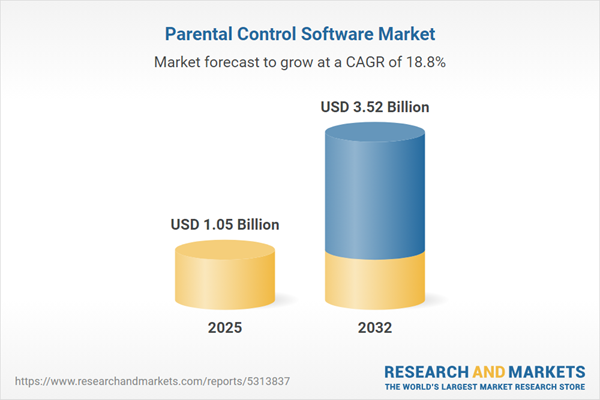Speak directly to the analyst to clarify any post sales queries you may have.
Parental control software is becoming essential for enterprises and institutions seeking robust digital risk management in a rapidly changing technology environment. With mounting regulatory scrutiny and growing device connectivity, organizations increasingly require adaptable solutions that streamline compliance, enhance operational resilience, and enable effective digital oversight.
Market Snapshot: Parental Control Software Market Size and Growth
The global parental control software market reached USD 886.65 million in 2024, projected to climb to USD 1.05 billion by 2025 at a compound annual growth rate (CAGR) of 18.84%. This momentum is fueled by the rise of digital wellbeing initiatives and the deployment of connected devices in enterprise and institutional settings. Organizations face increasing regulatory expectations, which heighten demand for secure, scalable parental control solutions. Public sector investment and the expansion of digital infrastructure contribute to strong market prospects, creating opportunities for tailored products that support compliance, policy enforcement, and technology integration across global regions.
Scope & Segmentation: Strategic Focus Areas in Parental Control Software
- License Types: Choices between one-time purchase and subscription licensing allow organizations to match software acquisition with their budgeting and approval frameworks.
- Platforms Supported: Cross-platform parental control solutions enable oversight across both desktop and mobile device environments, supporting company-owned and bring-your-own-device programs.
- Feature Types: Software capabilities cover application blocking, content filtering, screen-time management, and location tracking, providing organizations with layered protection and adaptable policy enforcement.
- End Users: Enterprises, educational institutions, and families each benefit from targeted features and compliance support, reflecting their varying digital risk profiles and operational requirements.
- Deployment Modes: On-premises and cloud-based options address organization-specific data governance needs and enable flexibility as requirements evolve.
- Regions Covered: North America, Latin America, Europe, Middle East, Africa, and Asia-Pacific all exhibit unique regulatory landscapes and technology adoption trends, shaping solution customization and support needs across geographies.
- Key Companies: Established vendors including NortonLifeLock Inc., McAfee LLC, AO Kaspersky Lab, Qustodio Inc., Bark Technologies Inc., ContentWatch LLC, Mobicip LLC, Kidslox Ltd., SafeDNS Inc., and Verizon Communications Inc. deliver regionally adapted solutions to meet sector-specific compliance and operational demands.
Parental Control Software Market: Key Takeaways
- Senior leadership is prioritizing more agile oversight of digital activity to meet complex regulatory requirements and address the evolving risk landscape.
- Deployment of artificial intelligence and machine learning enables real-time enforcement of parental control policies and identification of potentially harmful activity across user bases.
- Integrating privacy-by-design supports compliance goals and bolsters organizational trust in the stewardship of sensitive information.
- Centralized management empowers administrators to achieve consistent digital policy enforcement in distributed and hybrid device environments.
- Interoperability with device manufacturers and telecom providers allows easier rollout and maintenance across expanding digital infrastructures.
- Flexible procurement and pricing options accommodate cyclical budgeting and diverse compliance processes, maintaining organizational access to critical risk management tools.
Tariff Impact
Recent U.S. tariffs have raised costs for parental control solutions linked to proprietary hardware. In response, market leaders are shifting their focus to software-driven products to limit hardware exposure, improve supply chain resilience, and ensure ongoing compliance. This strategy helps organizations maintain consistent protection and operational continuity even during periods of supply or regulatory disruption.
Methodology & Data Sources
This analysis is based on expert interviews, reviews of key regulatory developments, and structured assessments of top vendor strategies and product portfolios. Combining market data and qualitative insight delivers a well-rounded perspective, supporting decision-makers with rigorously vetted information for product selection and risk management.
Why This Report Matters
- Comprehensive segmentation and clear benchmarks help streamline vendor selection and compliance decision-making in fast-changing regulatory environments.
- Deployment and end-user assessments equip organizations to align solution choice with operational objectives and future needs.
- Strategic insight empowers digital safety initiatives while facilitating compliance with changing data privacy and security standards.
Conclusion
Parental control software anchors organizational digital risk strategies, supporting secure, flexible digital environments. Strategic adoption equips decision-makers to address regulatory, security, and operational demands with confidence.
Additional Product Information:
- Purchase of this report includes 1 year online access with quarterly updates.
- This report can be updated on request. Please contact our Customer Experience team using the Ask a Question widget on our website.
Table of Contents
3. Executive Summary
4. Market Overview
7. Cumulative Impact of Artificial Intelligence 2025
Companies Mentioned
The companies profiled in this Parental Control Software market report include:- NortonLifeLock Inc.
- McAfee LLC
- AO Kaspersky Lab
- Qustodio, Inc.
- Bark Technologies, Inc.
- ContentWatch, LLC
- Mobicip LLC
- Kidslox Ltd.
- SafeDNS, Inc.
- Verizon Communications Inc.
Table Information
| Report Attribute | Details |
|---|---|
| No. of Pages | 192 |
| Published | October 2025 |
| Forecast Period | 2025 - 2032 |
| Estimated Market Value ( USD | $ 1.05 Billion |
| Forecasted Market Value ( USD | $ 3.52 Billion |
| Compound Annual Growth Rate | 18.8% |
| Regions Covered | Global |
| No. of Companies Mentioned | 11 |









